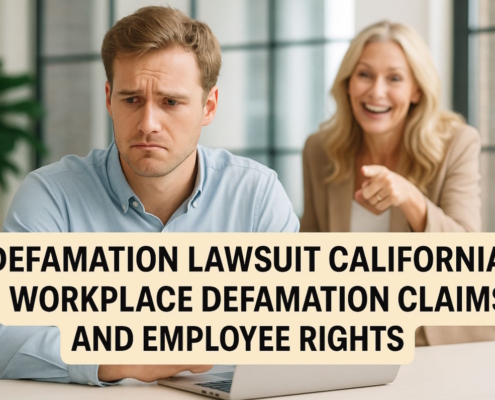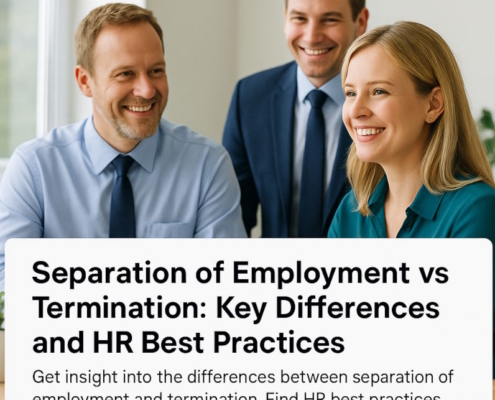Introduction
According to US labor law, an employer may fire an employee for any reason (i.e., without providing “reasonable cause” for the dismissal) and without prior notice, provided that the cause of dismissal is not unlawful (e.g., firing due to the employee’s race, gender, religion, sexual orientation, or disability condition). Courts deny employees who are recognized as having been recruited “at will” any compensation for damages incurred as a result of their termination.
Proponents of the regulation make the argument that a worker may have the same right to quit their work without cause or notice. According to those who believe that the job relationship is defined by unequal bargaining power, the practice is unfair.
Throughout the Lochner period, when American judges actively worked to stop the government from regulating labor markets, the United States Supreme Court supported the employment-at-will doctrine, which progressively evolved into the standard procedure under the standard law of employment contracts in the majority of US states in the latter part of the nineteenth century. Many governments altered the rules during the 20th century by adding more and more exclusions or by completely altering the employment agreement’s default expectations.
In most public sector employment and in workplaces where a trade union has been acknowledged for collective bargaining reasons, the employer is required to provide a “just cause” for termination. Other than statutory rights (including the Civil Rights Act’s restrictions on discrimination), most states follow the general rule that an employer and employee can agree on any kind of dismissal safeguard they like.
Employment at-will doctrine is still a contentious issue that is frequently discussed in legal and economics classes, particularly in relation to the macroeconomic viability of granting employers the authority to fire workers arbitrarily and summarily.
Definition
“A hiring is believed to be ‘at-will’; meaning, the company is free to terminate persons for good reason or bad reason or no reason at all, and the worker is equally entitled to leave, strike, or else halt work,” is the standard definition of at-will employment. The Supreme Court of California clarified in a ruling from October 2000, which essentially restated employers’ privileges pursuant to the employment-at-will doctrine:
Section 2922 of the Labor Code creates the assumption that an employer has the right to fire workers for any cause. Without offering particular rights like prior warning, transparent processes, objective assessment, or favored reassignment, the company may act abruptly, arbitrarily, or incoherently. Due to the “fundamentally contractual” nature of the employment relationship, any restrictions on the employer’s rights are subject to the stated or implicit agreement of the parties.
The mere fact that an employment connection exists does not give rise to any legally protected expectation that the job will continue or terminate solely under specific conditions, unless those terms have been officially agreed upon by the parties. The covenant does not, then, preclude the employer’s dismissal decisions if they do not violate such a basic contract condition, regardless of how irrational they may be.
In the US, disclaimers about at-will employment are common in manuals for workers. Employers often request that workers sign an acceptance of their at-will status, describe what an at-will position means, and explain that a worker’s position cannot be changed until the company’s chairman (or chief executive) signs a written document. The National Labor Relations Board, however, has ruled that it is illegal to include wording in these disclaimers stating that the at-will aspect of employment can’t be altered without senior leadership’s written approval.
History
The initial common law rule for firing employees, outlined by William Blackstone, stated that, lacking an agreement to the contrary, workers would be considered hired for a one-year term: “The agreement between them and their bosses arises immediately after hiring.” On the basis of natural fairness, the law interprets a general recruitment without a specific time limit as a recruitment for a year. The servant will serve and be maintained by the master during every change of the seasons, both when there is and is not work to be done. However, the contract can be drawn up for any length of time.
The majority of Northern states upheld the principle that the length of time a worker was paid—a year, a month, or a week—determined how long notice needed to be provided before a dismissal took effect during the 19th century. For example, the Massachusetts case of Tatterson v. Suffolk Company in 1870 determined that the default period for notice was determined by the employee’s employment tenure. However, in 1884, a judge in Tennessee ruled that a company should have the right to fire any employee, or a group of employees, for any cause.
According to the broad concept of freedom of contract, a person or collective agreement might always state that a worker should only be fired for a “just reason,” or that elected representatives of employees would have an input in whether the firing should occur. This was unusual, though, given the status of the average laborer in the 19th century.
Usually, the employment-at-will doctrine may be linked to Horace Gray Wood’s 1877 treatise Master & Servant. To support his contention that the servant had the burden of proving that an unlimited work term was for a year, Wood referenced four U.S. precedents. According to the Court in Toussaint v. Blue Cross and Blue Shield (Michigan), “Wood’s rule was rapidly cited as precedent for another claim.” But Wood misunderstood two of the cases, which demonstrated that, at least in Massachusetts & Michigan, the rule was that workers should be given notice before being fired in accordance with the terms of their contracts.
Wood’s rule was initially used in a New York case, Martin v. NY Life Insurance Co. (1895). According to Justice Edward T. Bartlett, New York law now complies with Wood’s thesis, meaning that a worker who receives $10,000 in salary over a year may be fired right away. There was no mention of the prior authority in the case. It had been decided four years prior in Adams v. Fitzpatrick that New York law adhered to the standard practice of mandating notice comparable to pay periods. But throughout the first half of the twentieth century, the at-will ruling persisted in later New York instances.
For certain courts, the rule meant that in order to sustain a claim based on cessation of employment, the employee had to demonstrate a written agreement for a specific term. This gave rise to the at-will employment policy in the United States, which permitted termination without cause. Every state in the union embraced this regulation. The first judicial exemption to the employment-at-will doctrine was established by a California Court of Appeals in 1959.
Later, in a historic decision involving ARCO in 1980, the California Supreme Court upheld the rule that the Court of Appeals had initially established. In California, the ensuing civil lawsuits filed by workers are now referred to as Tameny proceedings for wrongful dismissal in contravention of public policy.
At-will employment has been subject to a number of common law & statutory exceptions since 1959.
Employees who defy their employers on the basis that they were instructed to do something unlawful or immoral are protected from reprisal under common law. Nonetheless, in most situations, the fired employee still bears the responsibility of proof. Only Montana has decided to change the at-will job rule through legislation. Montana lawmakers enacted the WDEA (Wrongful Discharge from Employment Act) in 1987. The WDEA is special because it clearly lists the legal grounds for a wrongful termination case while also claiming to uphold the employment-at-will doctrine in employment law.
In the context of government personnel, civil service laws or an explicit agreement may supersede the at-will employment theory. The protection of some form of “just cause” or genuinely reasonable need for termination appears to apply to up to 34% of all American employees, which separates them from the simple “at-will” category.
This includes the 7.5% of private sector employees who are unionized, the 0.8% of non-unionized private sector workers who have union agreements, the 15% of non-unionized private sector workers who have specific express contracts that supersede the at-will rule, and the 16% of the workforce that enjoys constitutional safeguards as employees in the public sector.
By State
1. Exceptions to public policy
An employer is prohibited from terminating an employee using the public policy exemption if doing so would contravene a federal or state statute or the public policy tenet of the state.
This covers both refusing to take an action that would be against public policy and retaliating against a worker for carrying out an action that conforms with it (for example, repeatedly notifying the company that is shipping faulty aircraft components in breach of safety regulations established in relation to the Federal Aviation Act). The ‘exception’ in the pink states of this diagram protects the employee.
Forty-two states plus the District of Columbia recognized public policy as an exemption to the employment-at-will doctrine as of October 2000.
The following eight states don’t have the exception:
- Alabama
- Georgia
- Florida
- Maine
- Louisiana
- New York
- Nebraska
- Rhode Island
2. Exceptions to implied contracts
In addition, 36 states in the United States (as well as the District of Columbia) acknowledge implied contracts as an exemption to at-will employment. “When an implicit contract becomes established between a worker and an employer, even when no explicit written instrument detailing the relationship of employment exists,” an employer is prohibited from terminating an employee under the inferred contract exception.
It can be challenging to prove the conditions of an implied contract, and the fired employee bears the burden of proof. The most common instances of implied contract of employment occur when a company’s handbooks or personnel rules state that a worker will not be let go unless there is a good reason or outline a procedure for doing so. Employers may be held accountable for breach of agreement if they terminate an employee in breach of an implied contract of employment.
When using the implied-contract approach to get around at-will employment, consideration must be used. The Supreme Court of Texas ruled in Matagorda County Hospital v. Burwell that a worker’s at-will employment was unaffected by a clause in their handbook that said that terminations might be made for cause and required employee records to detail the basis for termination.
To avoid employment at will, the New York Court of Appeals, which is the highest court in that state, likewise dismissed the implied-contract approach. In Anthony Lobosco v. New York Telephone Company, the court reiterated the established principle that a worker could not file a wrongful discharge lawsuit in cases where state law did not acknowledge the tort of malicious discharge or provide an exception for dismissals that contravened public policy, and where a worker’s explicit disclaimer in their employee handbook maintained their at-will relationship with the company.
In the same 2000 ruling as previously stated, the California Supreme Court ruled that a worker’s successful and lengthy tenure does not prove an implied-in-fact agreement that prohibits termination without cause.
3. ‘Implied-in-law’ agreements
A violation of an implied promise of honest and fair dealing is an exception for at-will employment recognized by eleven US states. These states are:
- Alabama
- Arizona
- Alaska
- California
- Idaho
- Delaware
- Montana
- Massachusetts
- Utah
- Nevada
- Wyoming
Depending on the court, this might mean anything from needing “good cause” to rejecting terminations for nefarious motives, including firing a long-tenured worker only to avoid having to pay the individual’s accumulated retirement benefits. In other court decisions, the exception has been rejected, stating that it would be too onerous for the court to ascertain the real reason why an employer fired a worker.
Statutory exceptions
Montana and all other states are by default at-will. Montana, however, imposes a trial period, beyond which dismissal is only permissible if done reasonably.
While every state in the United States has several statutory safeguards for workers, federal anti-discrimination regulations, which forbid firing or refusing to employ an employee on the basis of color, race, religion, age, sex, national origin, or disability status, are usually used in wrongful termination cases filed under legal causes of action. Additionally, an employer cannot terminate an at-will worker for the following reasons:
When an employee declines to engage in unlawful behavior, the employer is not allowed to terminate them for this reason.
Most employees are allowed to take a period of absence due to particular family or medical issues under federal law. If a worker takes medical or family leave for a reason specified in the Family & Medical Leave Act, the employer is not allowed to dismiss them.
Retaliation against a worker for a protected conduct that the worker took—”protected acts” include filing a lawsuit for wrongful dismissal, testifying as an expert witness in an unfair dismissal case, or even challenging what they think to be wrongful prejudice, regardless of whether or not they can provide proof. Raymond Ross succeeded in suing his employer in the federal case Ross v. Vanguard for terminating him because he claimed to have experienced discrimination based on his race.
Employees who want to join or start a union, as well as those who participate in union activity, are protected by the National Labor Relations Act. Additionally, the act protects workers who participate in coordinated activities. The majority of firms publish their workplace policies and procedures in the workers’ handbook. One prevalent clause in those manuals is that employment is “at-will” with the hiring company.
The federal regulatory body in charge of upholding the NLRA filed two cases in 2012 that targeted at-will employment declarations found in handbooks for workers. The NLRB contested widely worded disclaimers, claiming that they violated the rights of employees under the NLRA by incorrectly implying that workers could not band together to try to alter the at-will character of their employment.
Controversy
The extreme harshness of the employment-at-will doctrine against workers has drawn a lot of criticism. It has also drawn criticism for being based on erroneous theories regarding the natural flow of knowledge and power in the relationship between an employer and employee. Nonetheless, libertarian legal and economic specialists like Richard Posner and Richard A. Epstein attribute the U.S. economy’s prosperity in large part to employment-at-will.
The growth of Silicon Valley, being an environment that encourages entrepreneurship, has also been attributed to at-will employment.
H. Verkerke clarified in a 2009 paper reviewing the scholarly literature from both domestic and foreign sources that “while everyone concurs that raising dismissal costs must inevitably deter both layoffs and fresh hires, predictions for every other factor heavily depend on the foundation of the framework and expectations about important parameters.”
The negative impact of increasing firing costs is widely acknowledged in mainstream economics, especially neoclassical economics. For instance, Tyler Cowen & Alex Tabarrok clarify in their economics textbooks that employers are less likely to hire workers if they are unsure of their capacity to fire them right away. However, contract theory states that in situations where there are market challenges, it may be advantageous to increase firing costs. For example, when asymmetric information plagues principal-agent interactions, Schmitz (2004) contends that employment protection regulations can be beneficial for society.
Lynn A. Karoly and James N. Dertouzos of the RAND Corporation conducted the first significant empirical study on the effects of exceptions to at-will employment in 1992. They discovered that acknowledging tort exemptions to at-will could result in a 2.9% decrease in total employment, and acknowledging contract exceptions could result in a 1.8% decrease. Verkerke claims that “great attention & publicity” were given to the RAND article. In fact, the conservative Cato Institute’s 2010 book included a positive citation.
Thomas Miles’s 2000 study, however, indicated that implementing the implicit agreement exception increases the usage of temporary employment by up to 15% but had no effect on overall employment. David Autor’s subsequent research in the mid-2000s revealed several shortcomings in Miles’ approach, verified the outsourcing phenomenon that Miles had identified, and found that the implicit agreement exception had no significant impact on aggregate employment, which fell from 0.8% to 1.6%.
In 2007, Autor and associates discovered that the good faith exception does, in fact, decrease job flows and appears to increase labor productivity while decreasing overall factor productivity. To put it another way, companies that are compelled to provide a “good faith” explanation for terminating an employee often automate processes to avoid hiring new staff, but this also lowers overall productivity because it becomes more difficult to remove ineffective workers.
Although their opponents point to studies that claim “job safety has a major adverse effect on employment rates,” other studies have discovered that at-will exceptions have an adverse effect on the return-to-work of dismissed workers who are still looking for replacement jobs. They also claim that hedonic regression analysis on at-will exceptions shows significant detrimental impacts on individual welfare in terms of wages, rents, and home values.































